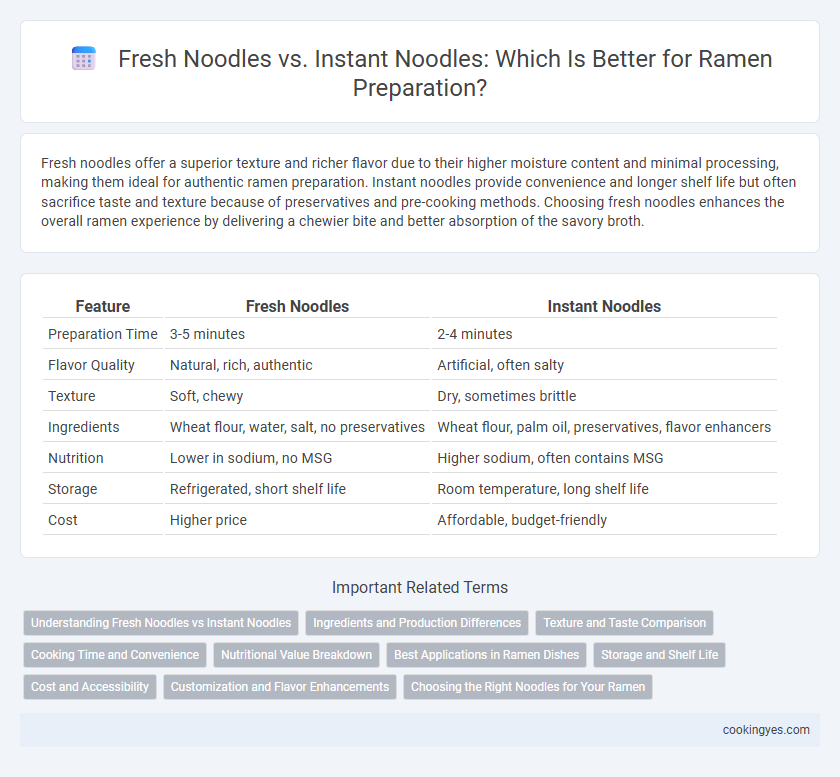Fresh noodles offer a superior texture and richer flavor due to their higher moisture content and minimal processing, making them ideal for authentic ramen preparation. Instant noodles provide convenience and longer shelf life but often sacrifice taste and texture because of preservatives and pre-cooking methods. Choosing fresh noodles enhances the overall ramen experience by delivering a chewier bite and better absorption of the savory broth.
Table of Comparison
| Feature | Fresh Noodles | Instant Noodles |
|---|---|---|
| Preparation Time | 3-5 minutes | 2-4 minutes |
| Flavor Quality | Natural, rich, authentic | Artificial, often salty |
| Texture | Soft, chewy | Dry, sometimes brittle |
| Ingredients | Wheat flour, water, salt, no preservatives | Wheat flour, palm oil, preservatives, flavor enhancers |
| Nutrition | Lower in sodium, no MSG | Higher sodium, often contains MSG |
| Storage | Refrigerated, short shelf life | Room temperature, long shelf life |
| Cost | Higher price | Affordable, budget-friendly |
Understanding Fresh Noodles vs Instant Noodles
Fresh noodles made from high-quality wheat flour offer a tender texture and rich flavor that enhances the overall ramen experience. Instant noodles, pre-cooked and dehydrated, provide convenience and quick preparation but often lack the depth of taste and elasticity found in fresh noodles. Understanding these differences is essential for selecting the right noodle type based on desired authenticity and preparation time.
Ingredients and Production Differences
Fresh noodles for ramen contain simple, high-quality ingredients like wheat flour, water, salt, and kansui, resulting in a chewy texture and rich flavor. Instant noodles are made through frying or air-drying precooked dough, incorporating preservatives and stabilizers for longer shelf life but often sacrificing texture and freshness. The production process of fresh noodles emphasizes minimal processing and freshness, whereas instant noodles prioritize mass production and extended storage.
Texture and Taste Comparison
Fresh noodles offer a chewier, more elastic texture and a richer, more nuanced flavor due to their higher moisture content and minimal processing. Instant noodles typically have a firmer, more uniform bite with a slightly alkaline taste resulting from the drying and preservation methods. The freshness of noodles significantly enhances the broth's absorption, creating a more harmonious and satisfying ramen experience compared to instant varieties.
Cooking Time and Convenience
Fresh noodles cook in 2 to 3 minutes, offering a tender texture and authentic flavor that enhances ramen dishes. Instant noodles require only 3 to 5 minutes, providing quick and easy preparation ideal for busy lifestyles. Choosing fresh noodles emphasizes quality and taste, while instant noodles maximize convenience and speed.
Nutritional Value Breakdown
Fresh noodles contain higher moisture content and retain more nutrients like proteins, vitamins, and minerals compared to instant noodles, which often undergo extensive processing and dehydration. Instant noodles typically have higher sodium levels, added preservatives, and lower fiber, contributing to reduced overall nutritional quality. Choosing fresh noodles enhances the intake of essential amino acids and micronutrients often diminished in instant varieties.
Best Applications in Ramen Dishes
Fresh noodles offer superior texture and absorb broth flavors better, making them ideal for traditional ramen dishes like Shoyu or Tonkotsu where rich, complex soups highlight the noodle quality. Instant noodles provide convenience and quick preparation, suitable for fast meals or fusion ramen styles where broth seasoning is simplified and speed is prioritized. For authentic ramen experiences, fresh noodles enhance taste and mouthfeel, while instant noodles serve well in casual or on-the-go scenarios.
Storage and Shelf Life
Fresh ramen noodles require refrigeration and have a short shelf life of 2-3 days, emphasizing the need for immediate consumption or quick freezing to maintain texture and flavor. Instant ramen noodles offer extended shelf life, often lasting 6-12 months at room temperature due to their dehydration and seasoning preservation methods. Storage conditions directly impact noodle quality, with fresh varieties demanding cold environments and instant options benefiting from dry, airtight packaging.
Cost and Accessibility
Fresh ramen noodles generally cost more due to their perishable nature and require refrigeration, making them less accessible outside specialty markets. Instant noodles offer a significant cost advantage, often priced under a dollar per serving, and boast widespread availability in supermarkets and convenience stores worldwide. The choice between fresh and instant noodles depends on budget constraints and access to proper storage or specialty food suppliers.
Customization and Flavor Enhancements
Fresh noodles offer superior customization options, allowing chefs to adjust thickness, texture, and ingredients to create a tailored ramen experience. Flavor enhancements are more pronounced with fresh noodles as they absorb broths and seasonings better, delivering a richer and more authentic taste. Instant noodles provide convenience but often lack the depth and adaptability found in freshly prepared noodle varieties.
Choosing the Right Noodles for Your Ramen
Fresh noodles, made from wheat flour and water, offer a chewy texture and absorb broth flavors better, enhancing the overall ramen experience. Instant noodles, pre-cooked and dried, provide convenience and a longer shelf life but often lack the depth of flavor and texture found in fresh noodles. Selecting fresh noodles is ideal for authentic ramen preparation, while instant noodles serve well for quick and easy meals without sacrificing all taste quality.
Fresh noodles vs Instant noodles for preparation Infographic

 cookingyes.com
cookingyes.com